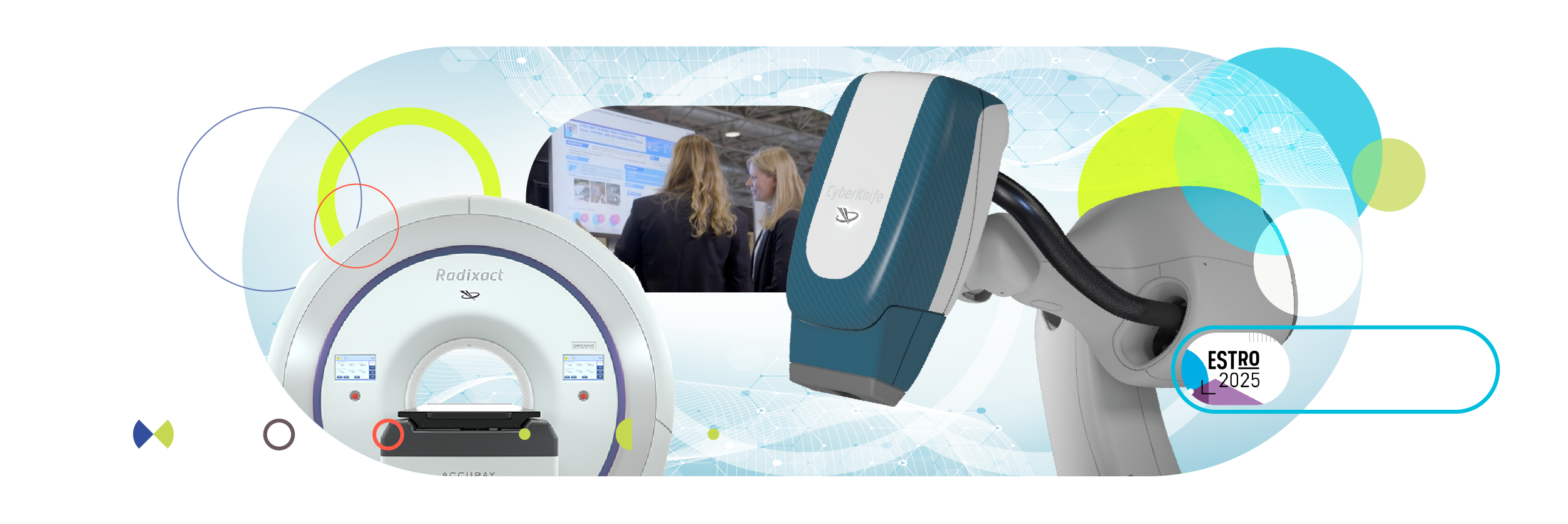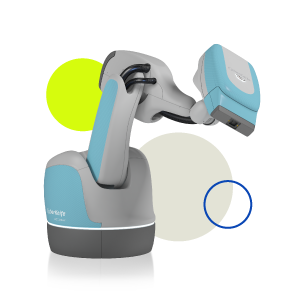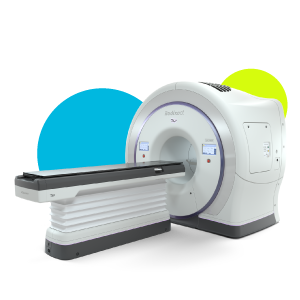At ESTRO 2024, we commemorated 30 years of transformative progress in the field of radiation therapy. Thirty years ago, the first patient was treated on the CyberKnife® System at Stanford University, USA. This groundbreaking technology has transformed radiation medicine. It was also three decades ago that the concept of dynamic helical delivery, utilized in the Radixact® System was conceived, pushing IG-IMRT possibilities well ahead of its time. Since then, a continuous focus on innovation and partnerships with clinicians and industry teams have helped to advance care worldwide.

Over the past three decades*, the CyberKnife System has amassed over 5,000 contributions in the literature, covering a diverse range of anatomical regions and therapeutic applications. In the same period, the TomoTherapy® System has similar contributions of over 4,500.
ESTRO 2024 Theme: Radiation Oncology - Bridging the Care Gap
This year’s ESTRO theme concentrated on bridging the care gap. This topic is highly important to help reinforce the position of radiotherapy as an essential cancer treatment that should be available to everyone. Everyone has the right to health and good quality care – but challenges lay ahead and unfortunately access to quality care is not always straightforward.
The Presidential symposium, “Bridging the care gap,” focused on several topics including addressing socio-economic gaps, national disparities, the East-West divide in Europe, and global considerations.
The 6 A’s of access were discussed:
- Availability – equipment and staff
- Accommodation – the need to stay nearby to the clinic during treatment
- Affordability – affordability of treatment itself, affordability of travel to the clinic, consequences of missed work
- Awareness – referring physicians awareness of radiotherapy indications, and a person diagnosed with cancer awareness of radiotherapy itself
- Spatial Accessibility – refers to the geography of centres (their location)
- Temporal Accessibility – timely access to care
All these points are related to the structure and process involved in
developing good quality care for a patient. And to achieve good outcomes for
people diagnosed with cancer, all of these points above need to be addressed.
Another consideration discussed was the need for national cancer plans
which is a critical component to a country’s health care system. It is hard to
believe but radiotherapy is often neglected when cancer plans are developed and
this needs to change. The Global Coalition of Radiotherapy (GCR) has developed
a framework of the key components
needed in a national cancer plan to help ensure important aspects
are included, whether creating a new plan or updating an existing one.
Listen to Darien Laird, Executive Director of GCR talk about the story behind GCR, and its aims to help improve equitable care for everyone around the globe.
Navigating The Oligometastatic Frontier: Strategies for Adaptation and Personalized Management
Oligometastases has emerged as a distinct and potential curable disease, where a shift from systemic and palliative only treatment focus to more targeted ablative therapies are occurring. And, there is evidence of improved outcomes with metastases directed-therapy. This year at ESTRO approximately 155 abstracts mention oligometastatic disease, clearly demonstrating it as an area of growing interest. In line with this, Accuray hosted a symposium on the management of oligometastatic disease. As people are surviving longer after their diagnosis of cancer it is imperative that ways to improve survival continue to be investigated. The symposium included insights and experience from Prof. Piet Ost, Prof. Nick van As, Prof. Barbara Jereczek-Fossa and Prof. Umberto Ricardi.
Many technology advances have allowed the progress and development of effective treatments for oligometastatic disease, in particular using imaging to characterize and identify patients suitable for this treatment. Personalizing the oligometastatic approach requires rigorous patient selection, and there must be a balance of safety considerations and navigating the interplay between systemic therapies with locoregional treatments. Make sure you watch the symposium to find out more.
Harnessing the Power: Radixact System and Surface Guided Radiation Therapy (SGRT)
Sofie Ceberg, Associate Professor, Medical Physicist from Lund University, Sweden presented a live webinar from ESTRO on the use of SGRT on the Radixact System. The research group at Skane Univerity Hospital have been instrumental in the early clinical development and implementation of optical surface-guided radiotherapy and have conributed to both ACROP-ESTRO and AAPM TG-302 guidelines, published in 2022. The benefits of SGRT on the Radixact System include:
- Real-time feedback on patient position
- Increased reproducibility
- Imaging without additional dose
- Sub-millimeter spatial resolution in 3D
- Largest field of view (FOV) in radiotherapy (135 cm length)
- Harnessed for total marrow iradiation (TMI) and deep inspiration breath hold (DIBH) positioning
- Possibility of margin reduction
An abstract by Mustafa Kadhim et al. from Skane University Hospital, Sweden also demonstrated SGRT with DIBH on the Radixact System helps to minimize dose to the heart and left anterior descending artery in breast cancer patients significantly compared to free-breathing techniques. This helps to support the feasibility and dosimetric benefits of combining SGRT and DIBH with TomoDirect™ on the Radixact System
ESTRO 2024 Abstract Highlights
CyberKnife System
- 6131: A phase 2 trial (STEAL study) on high-dose online adaptive SBRT for 52 patients with abdominal oligometastases using the CyberKnife System was presented. The team demonstrated a 1-year local control rate of 96% with minimal toxicity – this approach has become their new standard of care for these patients.
- 28292: Seventy-three patients with gynecological recurrence of which 53 were treated on the CyberKnife System. They found SBRT to be effective providing good local control and delayed time to systemic therapy by 12 months. This helps patients maintain a good quality of life for longer.
- 4913: The SPARC trial (Stereotactic prostate augmented radiotherapy with CyberKnife) is a phase 2 prospective trial treating the dominant intraprostatic lesion with a simultaneous integrated boost on the CyberKnife System. Twenty patients were treated with a median 30-month follow-up, with the primary outcome looking at acute toxicity. They showed this treatment is feasible and well tolerated.
Radixact/TomoTherapy System
- 7574: An independent evaluation of Synchrony® real-time tracking on the Radixact System was performed. By using a phantom and an independent monitoring device the team from Skane were able to determine that Synchrony accurately detected intrafraction motion of prostate tumors. The benefit of real-time tracking is that it allows a potential reduction in target margins during treatment. This not only helps to minimize dose to normal tissue but could also allow for dose escalation. Research that demonstrates accuracy helps increase confidence that what is planned is accurately delivered to the patient.
- 31095: Ten high-risk patients undergoing allogeneic hematopoietic stem cell transplantation with refractory leukemia were treated with a higher dose to the bone marrow (20 Gy versus standard 13,5 Gy) on the TomoTherapy System. At 22 months post-transplant none of the patients experienced a relapse. They concluded that 20 Gy is feasible in total marrow irradiation (TMI) with acceptable toxicity for these high-risk patients. This is important for patients with chemotherapy-resistant leukemia, offering them an alternative treatment path.
- 34076: A randomized phase 3 trial on the efficacy and toxicity of 60 Gy in 30 fractions versus 60 Gy in 20 fractions in 146 stage 3 non-small cell lung cancer patients using the TomoTherapy System. No significant differences in grade 2 or greater toxicity were found between the 2 groups. The clinical trial showed moderately hypofractionated radiotherapy improves overall survival in this category of patients. It also continues to help patients benefit from shorter overall treatment times, which can help increase patient throughput.
References
- Lucy A. van Werkhoven et al ‘Outcomes of a phase II trial of high-dose online-adaptive SBRT for abdominal oligometastases’ ESTRO 2024
- Benjamin J Thomas et al. ‘Outcomes of pelvic reirradiation with stereotactic radiotherapy for gynaecological cancer recurrence’ ESTRO 2024
- Binnaz Yasar et al ‘SBRT Focal Boost for Localised Prostate Cancer: Primary Outcomes of the SPARC Prospective Trial’ ESTRO 2024
- Klara Stefansson et al ‘Independent validation of real-time prostate localization for MLC tracking in phantoms and patients’ ESTRO 2024
- Simonetta Saldi et al ‘Intensified total marrow irradiation in high-risk HSCT patients’ ESTRO 2024
- Huang Wenhan et al ‘Efficacy and toxicity of moderately hypofractionated radiotherapy via helical TomoTherapy versus conventional radiotherapy combined with concurrent chemotherapy for patients with unresectable stage III non-small cell Lung Cancer: a multicenter, randomized phase III trial’ ESTRO 2024









